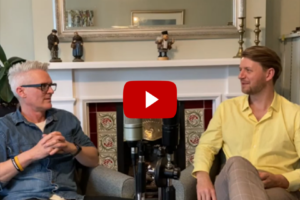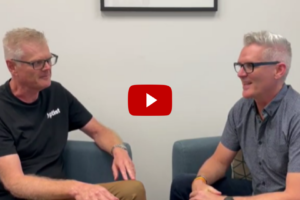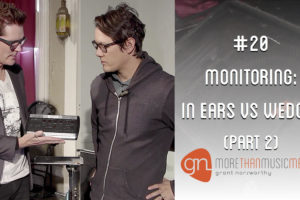Grant spoke with Dominic Schryvers from The Stations and the Gregorian Chat YouTube Channel about…
M3 VIDEO #10 – CHOOSING THE BEST KEY
By Grant Norsworthy
The video above is #10 in the More Than Music Mentor training resource series.
Not long ago I was speaking with a very talented, professional “worship artist”, “worship leader” and (male) friend of mine. Together with a female vocalist, we were preparing to play and sing Phil Wickham’s “This Is Amazing Grace” together at a “Night Of Praise” special event.
It was clear to me that we were preparing to lead it as a congregational song. The words would be on screens. The congregation would be asked to sing with us as an expression of worship.
It was a new song for me to learn, but my friend had been singing it as part of his repertoire for his home congregation for some time. I asked him in what key he usually did the song. “B flat – same as Phil Wickham!” he shot back with a confident smile.
I was impressed. But also a little saddened.
I was impressed because that means my friend possesses some serious vocal range – like Phil Wickham (and Chris Tomlin and many other popular male “worship artists”). I was saddened because, like me, perhaps 95% of men are unable to sing that high! Most women can sing in that register, but only by singing in the same octave as the male leader. The octave above the male leader (which is usual) is impossible for perhaps 95% of all women for that song in B flat!
I was saddened because I think my friend had very little idea of how difficult his congregation would find singing “This Is Amazing Grace” with him in the key of B flat. But I have little doubt that his voice sounds great up there.
Singers are a funny bunch. We can be so insecure and tend to think about ourselves too much. As leading vocalists in service of The Christian Church, we often and easily become confused about the main purpose of why we are singing. We can become so focused on what we are singing and how we sound as we are singing, that we forget some absolutely essential points:
- We are not performing for an audience, but we are inviting the congregation to sing along.
- We are not primarily on the platform with a mic to have people listen to us, but to be guided by us.
- We ought not be trying to impress people with our vocal ability, but to encourage others to sing passionate, sincere praises to God as an expression of worship.
- We should make singing along with us as inviting and easy as possible for the whole congregation – both male and female, young and old, musically capable or not.
Evidence of this “performance or guidance” confusion is seen no more clearly than in the choices of keys for congregational songs.
When choosing the key for a song that is to be sung by a Church congregation, I must not be thinking primarily about my voice, the key I want, where I think I will feel the most comfortable singing. I must be thinking first of the congregation and their vocal ability – a key that suits them.
I need to do all I can to find a key where almost every male and every female in the room can sing with confidence. For capable, experienced vocalists, this may well be – in fact, will probably be – a different key to where I would prefer to sing the song if I were performing for an audience.
This can be a tough thing to do for some songs – especially those that have a wider – more than an octave – range. Many modern “worship songs” utilize a chorus melody that launches considerably higher than the verses. It feels exciting to sing higher in the chorus in contrast to the lower verses! It works very well as a musical technique.
Some songs actually have the melody jump a whole octave at a particular point – Matt Maher’s very popular “Lord I Need You” as an example. Our hearts are stirred with emotion and the sound of the leader’s voice when they make that jump with just the right lyric!
But we ought to be aware that these techniques favor a performance style of singing and make it very tough for a whole congregation to sing along. If performance is the purpose, I say “Go for it!” and sing your performance as an expression of worship. But if you are the person picking the keys for songs, make your choices wisely – being aware of the benefits and the costs from the congregation’s point of view.
For my part, if the words are on a screen, if the objective is to invite a body of believers to sing truths of Almighty God, to cry out to Him and to praise Him, I will do my best to present songs using a key where as many people as possible know that they can sing along. It will help them to want to sing.
Oh. And to tie up the loose end of the story with my friend and I preparing “This Is Amazing Grace”: We spoke, we tested a few keys, checked where the melody would suit guys and gals and agreed on the key of E. Not the most exciting key for us guys with microphones, but the congregation sang very well indeed.
In this instructional video for Church musicians, I demonstrate the process of choosing the best key for congregational singing with “This Is Amazing Grace” as the example song. In particular, I show how the best key may differ from the key of the song as it’s heard on the radio AND how it may be different from the key in which the leader would prefer to sing the song.
Watch Video#10 – Choosing The Best Key again.
For more free resource videos and info, visit www.MoreThanMusicMentor.com.


